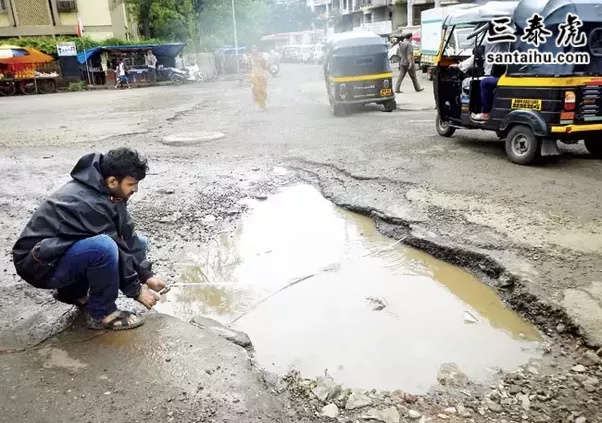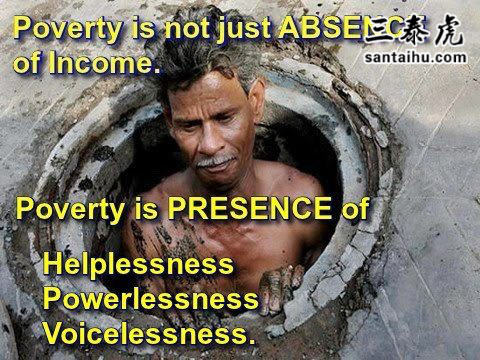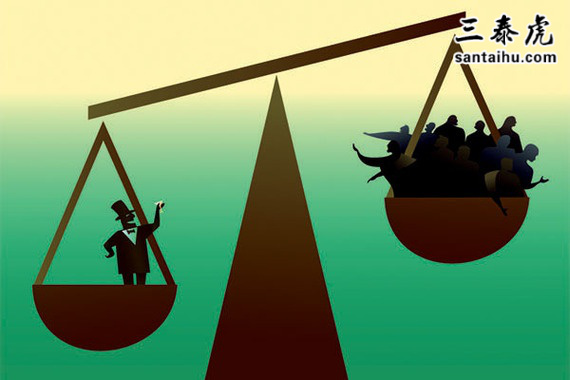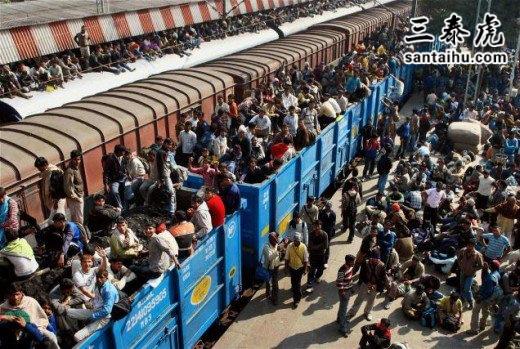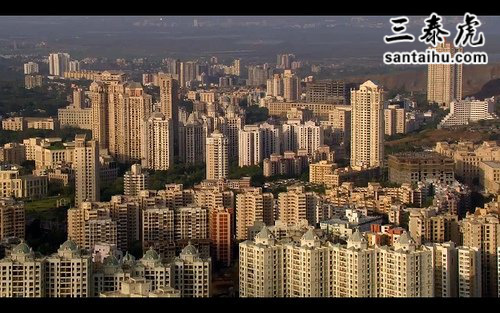印网友热议:为什么印度是世界上最大的贫困国家
Why is India the largest poverty country in world?为什么印度是世界上最大的贫困国家?QUORA网站读者评论:Piyush Gupta, studied
Why is India the largest poverty country in world?
为什么印度是世界上最大的贫困国家?
QUORA网站读者评论:
Piyush Gupta, studied at Nagindas Khandwala College of Commerce & Arts
Here are some of the reasons why I think India is poor
1. Poor Education System
This is the biggest reason why India is poor. Some of you might argue that India has best Education Institutes like IIT and NIT, but lets face it, not everyone goes to IIT's or NIT's. Moreover, a lot of IIT's and NIT's wish to work abroad because they don't get the best opportunity here(well, this is a different problem altogether). But, we DO have a poor education system. Most of the Schools are opened not to provide better education, but they are setup to loot parents. Students are still beaten in schools. Local colleges are to their worst in studies. They don't have qualified teachers, they don't provide better Infrastructure. A lot of students end up in Call Centers(its a dream job for some of them), sales agencies, etc
以下是我认为印度贫穷的一些原因
1。教育体系薄弱
这是印度贫困的最大原因。有些人可能会说印度有最好的教育机构,比如印度理工学院和全印理工学院。但我们得承认,不是所有人都能入读这两所学校。此外,许多印度理工学院和全印理工学院的学生希望去国外工作,因为他们在印度得不到最好的机会(好吧,这完全是另一个问题)。我们的教育系统确实很差。大多数学校并不是为了提供更好的教育而开设,而是为了洗劫父母。学生们在学校里仍然会挨打。地方院校的学习成绩最差。他们没有合格的教师,未能提供更好的基础设施。很多学生最后都进了呼叫中心(对他们中的一些人来说,这已经是一份梦寐以求的工作)、销售机构等等
2. Almost everything in India is biased
Well, we have a special word for this term: 'Jugaad'
One of my friend applied for TC(Ticker Collector) job. As far as I remember, he was not that smart than other guys who appeared for the exams along with him.
But still, he managed to get the job because his uncle and his cousin brother were Ticket Collectors. He paid 1 lakh as bribe and got the job.
Fun-Fact: A lot of brokers are involved in the selection process. They usually ask for 6 lakhs - 8 lakhs as bribe.
2。印度几乎所有的事情都是不公平的
我们对此有个专门的术语:Jugaad
我的一个朋友申请了股票经纪人的工作。据我所知,他并不像其他和他一起参加考试的人那么聪明。
但尽管如此,他还是得到了这份工作,因为他的叔叔和表哥都是交易员。他行贿了10万卢比得到了那份工作。
有趣的事实:很多经纪人都参与了选人过程。他们通常要求60 - 80万卢比的贿赂。
3. Inequality
Lets face it, government just says that 'EVERYONE IS EQUAL'. They want us to believe that Everyone is equal despite of cast, creed, race, etc. But do they follow this?? They have special quotas for OBC, SC and ST student.
Obviously, government wants to support them, but I've seen a lot of (rich)people pay lakhs to rupees to get OBC certificate. They tend to use these government scheme to benefit themselves too.
3.不平等
让我们面对现实吧,政府只说‘人人平等’。他们希望我们相信不管他们的种姓、信仰、人种等是什么,每个人都是平等的。他们对OBC, SC和ST学生提供了特殊的配额。
很明显,政府想要支持他们,但是我也看到过很多(富人)为了获得OBC证书而行贿。他们想用这些政府计划来造福自己。
4. Everyone is busy looting
I am from Mumbai, so we have Reliance Energy as the dominant Electricity Supplier, and this company is charging like HELL. My Neighbor received a Electricity bill of 4000 INR a month and everything he has at home is a TV, a Tube-light and a fan. I received a bill of 3000 INR (normally it used to be about 650 INR).
4。每个人都忙着抢劫
我来自孟买,所以我们的信实能源是主要的电力供应商,而这家公司的收费简直是添加。我的邻居每月收到4000卢比的电费,他家里只有一台电视,一个管灯和一台风扇。我收到了3000 INR的账单(以往正常只要650 卢比)。
5. Government don't want our country to improve
Here are some of the roads in Mumbai. Mumbai is said to be the Economic Capital of India
5。政府不想让我们的国家进步
这是孟买的一些公路。孟买据称是印度的经济首都
Balaji Viswanathan, Indian by Birth. Indian by Thought.
Let us get the inequality out of the way, first. Here is the chart of "gini coefficient" that is the international standard for measuring inequality. Low scores mean low inequalities. Except for the Scandinavian countries & Japan, very few others fare better than India in this score. Also, any fast growing country cannot avoid some level of inequality. Growth will always be unequal. Even the Scandinavians were a lot unequal during their growing stages (couple of centuries ago).
In short, our problem is not one of things shared unequally, but one of not enough things to share. We started worrying about inequality too early.
Causes for our poor growth:
首先,让我们把不平等去掉。这是衡量不平等的国际标准“基尼系数”的图表。分数低意味着不平等程度低。除了北欧国家和日本,很少有其他国家的表现比印度好。此外,任何快速发展的国家都无法避免某种程度的不平等。增长总是不平等的。即使是斯堪的纳维亚人在他们的发展阶段(几个世纪前)也存在很多不平等。
简而言之,我们的问题不在于分配不平等,而是没有足够的东西去分享。我们很早就开始担心不平等。
经济增长缓慢的原因:
1.After the World War II in 1940s, when most Asian countries got freed, there were a group of countries that when on socialism and others leaned on a capitalistic path. The latter group (included S. Korea, Thailand, Japan, Singapore, Malaysia, etc) was able to significantly outperform the former (China, India and Vietnam). China saw the folly of socialism by 1970s and Deng significantly modernized started from 1970s. However, we were stuck to failed ideas of socialism way too long. See China's economic curve diverging from India's in late 1970s.
1。在20世纪40年代的第二次世界大战之后,当大多数亚洲国家获得自由时,有一群社会主义国家和其他国家都倾向于走资本主义道路。后者(包括韩国、泰国、日本、新加坡、马来西亚等)的表现明显优于前者(中国、印度和越南)。20世纪70年代,中国的邓小平开始进行现代化改革。但是,我们坚守失败的社会主义太久了。看看中国的经济曲线和印度在上世纪70年代末的差异吧。
2.Poor leadership. In 1947, unfortunately, Nehru became a premier of India trouncing over more effective leaders such as Patel and Rajaji. Nehru had little clue of economics and little appreciation for entrepreneurship. He focused little on rural sector, agriculture or primary education. He was trying to build himself a stature in international politics with the failed NAM initiative and really failed in the domestic arena.
2。领导不佳。很不幸,1947年,尼赫鲁成为印度总理,击败了帕特尔和拉贾吉等更有影响力的领导人。尼赫鲁对经济学几乎一无所知,对创业也不怎么鼓励。他很少关注农村部门、农业或初等教育。他试图通过失败的不结盟运动倡议在国际政治中建立自己的地位,在国内舞台彻底地失败了。
3.Poor direction on liberalization. Think about the top paying jobs in India. They would be in technology, outsourcing services, finance, advertising and other services where government has given freer room for entrepreneurs to operate. However, when it comes to mass employment generation sectors of agriculture or retail, we have kept our cards way too close and have not liberalized at all.
3。对自由主义的引导不足。想想印度的高薪工作。集中在技术、外包服务、金融、广告和其他服务领域,在这些领域,政府为企业家提供了更大的运营空间。然而,当涉及到农业或零售业等大量创造就业机会的行业时,我们不舍得投资。
4.India took on to democracy far too early. Most rich nations subverted democracy during their growth stages. Great Britain of Dickensian era, USA of gilded age, Japan during the imperial era, Thailand, S.Korea before 1979, Singapore during Lee Kwan Yew's era, all had autocrats or crony capitalism. We kind of put cart before the horse by our early adoption of democracy. We could still win, but we are into an uncharted territory. No other nation has built up their economy as fast in a perfect democracy. This point is controversial though.
4。印度接受敏煮的时间太早了。大多数富裕国家在其发展阶段进入敏煮。狄更斯时代的英国,镀金时代的美国,帝国时代的日本,泰国,美国。1979年前的韩国,李光耀时代的新加坡,都有读才者或权贵资本主义。我们那么早就采用敏煮制度有点本末倒置。我们仍然可以赢,但是我们进入了一个未知的领域。在一个完美的敏煮国家里,没有哪个国家的经济发展如此之快。这一点是有争议的。
5.Finally, there are many Indians. The India of the middle and upper class is a different one. And we have been in "poverty thought" way too long and it has not helped. When we were long in school, my friends used to talk about India as "It Never Develops in Anything" and that kind of attitude got us nowhere. It is good that we are coming out of that "poverty trap". You cannot win by just focusing on your negative attributes.
5。最后,印度人口众多。印度的中产阶级和上层阶级是不同的。我们局限于“贫困思想”之中太久了,但这并没有帮到什么忙。我的朋友们常说印度“在任何方面都不会发展”,这种态度让我们一无所获。我们正走出“贫困陷阱”,这是件好事。只关注自己的不足是无法取胜的。
Ashutosh Mehndiratta, Curious Indian
Wealth and Poverty are relative terms. When we say India is so poor, it is in reference to the countries that we consider wealthy. While it's important to study why India is poor (and the answers on this thread have pretty much covered it), it's equally important to study why some countries are wealthy.
富裕和贫穷是相对的。当我们说印度如此贫穷时,我们参考的是那些我们认为富裕的国家。尽管研究印度为什么贫困很重要(这篇文章的答案几乎涵盖了这一点),但研究一些国家为什么富裕同样重要。
How did wealthy nations become wealthy? Few common traits of wealthier nations are that they are industrialized, have high literacy levels, replacement population growth rate (~ 2.0 births per woman) or even lower, have robust institutions (political, financial, legal) regardless of their geography and arguably culture. As these countries developed, their work force shifted its focus from agriculture to manufacturing to services. Economists have called the onset of Industrial Revolution in late 1700s to early 1800s as a key point of economic divergence between countries of the world. Despite having colonial empires, European countries were still not too far ahead of countries like India and China in 1600s and 1700s. Things simply took off when machines could do tasks at a mind boggling speed compared to humans. Industrial Revolution began in the UK and was picked up by Germany and France and subsequently the US and other Western nations. Later Japan followed by South Korea and recently China followed suit and witnessed exponential economic growth. These countries then get in a positive loop.
富裕国家是如何变富裕的?富裕国家的一些共同特征是:工业化程度高、识字率高、人口更替率(每名妇女生育约2.0个孩子)甚至更低,无论其地理位置和文化如何,都有健全的制度(政治、金融、法律)。随着这些国家的发展,劳动力重心从农业转向制造业,转向服务业。经济学家将18世纪末至19世纪初的工业革命称为世界各国经济分化的一个关键点。尽管拥有殖民帝国,但在17世纪和18世纪,欧洲国家还未远远领先于印度和中国等国。与人类相比,机器可以以惊人的速度完成任务。工业革命始于英国,随后被德国、法国、美国和其他西方国家所接受。后来,日本紧随其后,然后是韩国,最近中国也加入队列,经济呈指数级增长。然后这些国家就进入了良性循环c
India's situation - India on the other hand is caught in a negative loop of 'Overpopulation-Illiteracy-Corruption-Poverty'. With a denominator of 1.25 billion population, even if we apply it to GDP of the mighty US, on a per capita basis it drops to ~ $14,000 and that would drop US' rank to 50th in the world! So population matters. In 1947, India's population was around 300 million and we have quadrupled since then. It will peak around 1.7 billion in the next 25 years. Population growth is inversely proportional to Literacy. The poorest states in India have the lowest literacy levels and the highest fertility rates.
印度的情况——另一方面,印度陷入了“人口过剩-文盲-腐败-贫困”的恶性循环。在人口高达12.5亿的情况下,即使我们把这个人口数套用到美国强大的GDP中,人均GDP也会下降到1.4万美元,世界排名下降到第50位!所以人口是个大问题。1947年,印度人口大约为3亿,自那以后我们的人口翻了两番。在未来25年里,这个数字将达到17亿左右的峰值。人口增长与识字率成反比。印度最贫穷的州识字率最低,生育率最高。
Post-independence roadmap - Pandit Nehru was a brilliant man but not an economist. His economic vision turned out to be flawed and we ended up with useless Planning Commission and their 5-year plans as well as License Raj that choked India's potential. But to be fair to him, we have to realize that his tenure was only 17 years before he passed away in 1964. The initial years of his leadership post-Independence were spent battling post-partition issues and getting basics in place. His successors should carry a larger blame for the Hindu rate of growth from 1964 all the way till early 90s.
Today India is in a unique position where 60% of workforce is engaged in agriculture compared to less than 5% in developed countries and has sort of skipped a boom in Industry/Manufacturing and jumped to a booming Services sector. But services sector is not able to generate employment for the 12 million Indians that enter the work force each year. Therefore, manufacturing has to be the way to go. PM Narendra Modi has correctly identified 'Make in India' as a top priority and hope he is able to execute this vision.
Where is India headed? Fortunately, situation has been improving rather drastically.
独立后的路线图——潘迪特·尼赫鲁是一个聪明的人,但不是一个经济学家。他的经济愿景被证明是有缺陷的,我们最终得到了无用的计划委员会和五年计划,以及扼杀了印度潜力的许可证制度。但公平地说,我们必须认识到,他的任期只有17年,1964年他就去世了。在他独立后的最初几年里,他一直在与分裂后的问题作斗争,并解决了基本问题。从1964年到90年代早期,他的继任者应该对印度的经济增长率负更大的责任。
如今的印度很特别,60%的劳动力从事农业,而在发达国家,这一比例还不到5%。但服务业无法为每年进入劳动力大军的1200万印度人创造就业机会。因此,必须走制造业这条路。印度总理纳伦德拉莫迪已经正确地将“印度制造”列为首要任务,希望他能够实现这一愿景。
印度将何去何从?幸运的是,情况已大大改善。
Kathan Shah, Reading to understand things...
The difference between the poor and rich is not the age of the Nation.
This can be demonstrated by countries like India and Egypt, which are more than 2000 years old and are still poor countries.
On the other hand, Canada, Australia and New Zealand, which 150 years back were insignificant, today are developed and rich countries.
The difference between the poor and rich nation does not also depend on the available natural resources.
Japan has limited territory, 80% mountainous, unsuitable for agriculture or farming, but is the third in worlds economy. The country is like an immense floating factory, importing raw material from the whole world and exporting manufactured products.
穷人和富人的区别不在于国家的历史。
这一点可以从印度和埃及等拥有2000多年历史的穷国身上得到证明。
另一方面,150年前无足轻重的加拿大、澳大利亚和新西兰如今都已成为发达和富裕的国家。
穷国和富国之间的差异也不取决于可用的自然资源。
日本国土面积有限,80%是山区,并不适合开展农业或农业生产,但却是世界第三大经济体。这个国家就像一个巨大的浮动工厂,从世界各地进口原材料,出口制成品。
Second example is Switzerland, it does not grow cocoa but produces the best chocolates in the world. In her small territory she rears animals and cultivates the land only for four month in a year, nevertheless manufactures the best milk products. A small country which is an image of security which has made it the strongest world bank.
Executives from rich countries who interact with their counterparts from poor countries show no significant intellectual differences.
The racial or colour factors also do not evince importance: migrants heavy in laziness in their country of origin are forcefully productive in rich European countries.
第二个例子是瑞士,它并不种植可可,但却能生产出世界上最好的巧克力。在瑞士的小小领土中,他们饲养动物,土地一年只耕种四个月,然而她却出产了最优质的奶制品。这是一个小国,是安全的象征,使其成为最强大的世界银行。
来自富裕国家的高管与来自贫穷国家的高管互动时,智力上没有明显差异。
种族或肤色因素也并不重要:移民在其原籍国极度懒惰,在富裕的欧洲国家却很勤快。
Then what is the difference?
The difference is the attitude of the people, moulded for many years by education and culture.
When we analyse the conduct of the people from the rich and developed countries, it is observed that a majority abide by the following principles of life:
那区别到底在哪儿呢?
不同的是人们的态度,是由多年的教育和文化所塑造的。
当我们分析富国和发达国家人民的行为时,可以看到大多数人遵守下列生活原则:
- Ethics, as basic principles.
- Integrity.
- Responsibility.
- The respect for Laws and Regulations.
- The respect from majority of citizens by right.
- The love for work.
- The effort to save and invest.
- The will to be productive.
- Punctuality.
1。道德,重中之重。
2。诚信。
3。责任感。
4。尊重法律法规。
5。大多数公民的尊重。
6。对工作的热爱。
7。努力储蓄和投资。
8。生产的意志。
9。守时。
In the poor countries a small minority follow these basic principles in their daily life.
We are not poor because we lack natural resources or because nature was cruel towards us.
We are poor because we lack attitude. We lack the will to follow and teach these principles of working of rich and developed societies.
在贫穷国家,少数人在日常生活中遵循这些基本原则。
我们之所以贫穷,不是因为我们缺乏自然资源,也不是因为大自然对我们无情。
我们贫穷是因为我们缺乏正确的态度。我们缺乏遵循和传授富裕和发达国家可行原则的意愿。
Vivek Vermani, studied Computer Science
There is no fair competition and the system doesn’t help the productive people. Having said that I am not just blaming Reservation but also the corrupt practices and patterns that give under deserved the ladder to surpass the deserved.
Corrupt Academic System - Last year Bihar state govt became strict and hence only 44% could pass the 10th board examination. In spite of that strictness , we have a 12th board topper who hardly knows her subject names. This gives a rough figure of more than 60% people who have earlier cleared the exam by either cheating ( in a big way ) or paid bribe. Other states might be little better but it’s somewhat way of life everywhere.
Impact of this - Leave aside these people posing competition to others in later exams, Many of such belonging to reserved categories are already qualified for many govt jobs. Just think of the likes of Ruby Roy taking care of your money in the govt bank.
没有公平的竞争,而且这个制度对勤劳的人没有助益。我已经说过,我不仅谴责预留制,而且还谴责腐败的做法和模式,让不该享受益处的人超越理应享受益处的人。
腐败的学术体系——去年比哈尔邦政府采取严格措施,因此只有44%的人能通过第十届委员会考试。尽管如此严格,我们还是有12年级的高分者几乎不知道自己的专业名。这个粗略的数据显示,有超过60%的人之前是通过作弊(很大程度上)或行贿通过考试的。其他邦可能也好不到哪儿去,这在某种程度上可能已经是见怪不怪了。
影响-撇开这些人在以后的考试中与他人竞争不谈,许多属于预留类别的人已经有资格胜任许多政府工作。想像一下鲁比·罗伊这样的人在政府银行里打理你的钱。
Pattern of Entrance Exam - So in single day with 2 - 3 hours exam we get to understand that who can be an Engineer or who cannot be. Let me tell you an idea on how to succeed in such entrance exam without being capable of it. Spend some money and clear your board exams and just focus on those entrance exams for few years. If I was asked to just prepare for IIT exams for 3 years and leaving aside my regular curriculum, I could have been an IITian too.
Reservation - I will not give any info as its already much talked about subject.
入学考试——在一天中通过2 - 3个小时的考试,我们就能知道谁能成为工程师,谁不能。让我告诉你如何在没有能力的情况下成功参加高考的办法。花点儿钱,通过入学考试,几年内只想考试的事。如果我要为IIT考试备考3年,而不用考虑我的常规课程,我也可以成为一名印度理工的学生。
预留-我不想再谈,因为已经有太多人谈论过了。
Corruption in Companies - If you think that you can get into a Govt job only by paying bribe , think twice. There are numerous private companies around you where you can pay some money to recruiter / HR and get through. In addition to this. some HR will only get people through a particular recruiting agency and hence your capability will sound better if your resume is sent by the chosen ones.
So these are the causes and now Lets see how this impacts the productivity of the system.
System has already ignored 7 out of 10 hard working and capable people who were way better than the ones whom we have selected.
公司里的腐败——如果你认为你只有通过行贿才能进入政府工作,请三思。在你身边会有很多私人公司,你可以向招聘人员或HR支付一些钱,然后通过征选。除此之外。一些人力资源部门只会通过特定的招聘机构招聘员工,因此如果你的简历是由他们推荐的,那么听起来你的能力会更好。
这些是原因,现在我们来看看这会如何影响系统的生产力。
系统已经忽略了70%的努力工作和有能力的人,他们比我们选出的那些人要优秀得多。
Suranjana Dutta, High Schooler, Trying to Score Marks
India is a rich country lived by largely poor people. What makes the condition of India look poor is poverty and this is because -
印度是一个贫困人口占大多数的富裕国家。让印度看似贫穷的原因是贫困,这是因为
1.Social Inequality - Though since 1947, considerable changes has took place in people's attitude but even today rural India, which is 70% of India, are still very 'caste conscious' compared to the urban society where education and financial well beings has certainly erased caste system. Society cannot progress if certain sections of people are left out simply because they belong from wrong class, caste, ethnic, race, color or creed. These segment of society like tribal community are very much detached from education and the “free” governments after 1947 never bothered to assimilate them into rest of the mainstream society and the tribal communities continued to remain isolated and “barely governed.” These segments of people have been subsisted to do only those tasks considered “unfit” for the other castes. Their un-touchability can be considered the worst form of rejection by the mainstream society.
2.Illiteracy - High level of illiteracy, particularly in the rural areas and among women, has been a crucial factor not only in economic backwardness but also for high population growth.
1。社会不平等——尽管自1947年以来,人们的态度发生了相当大的变化,但即便是今天,占印度70%的农村地区,与教育和财政状况良好的城市社会相比,仍有很强的“种姓意识”。如果因为某些人属于错误的阶级、种姓、人种、肤色或信仰,就要被排除在外,社会就无法进步。像部落社区这样的社会群体与教育完全脱节,1947年后的“自由”政府从未费心将他们同化到主流社会,部落社区继续保持孤立,“几乎没有管理”。这些人只能从事那些“不适合”其他种姓的工作。他们的贱民身份可以被认为是被主流社会拒绝的最糟糕形式。
2。文盲率- -特别是在农村地区和妇女中的高文盲率不仅是经济落后的一个关键因素,而且也是人口高增长的一个关键因素。
3.Population- While the growth rate of population has decreased significantly over the decades since 2011, India's population is currently growing annually at the rate of about 1.4 percent. Early marriage of girls and lack of awareness about reproductive healthcare, particularly in the rural areas, are major factors behind current population growth. Population is clearly a factor contributing to, and sustaining, high levels of poverty.
4.Gender inequality- Indian social fabric has left women significantly exploited and discriminated. Indian Muslim community is probably most backward in terms of gender inequality. Women are confined inside the veils and oppressed by polygamy and 'triple' Talaq. Indian women's weak status, particularly in the rural areas, is at the root of most chronic problems. It is their lack of awareness or access to family planning tools and early marriage of girls and their early child bearing, which ultimately have led to high population; lack of awareness of health issues related to pregnancy and child upbringing has resulted in high mortality rate, under-nutrition and malnutrition among children; lower education and lack of freedom has resulted in low participation in societal processes. All these factors are enough to feed and sustain poverty
3.人口——尽管自2011年以来的几十年里,印度人口增长率显著下降,但印度人口目前每年仍以1.4%的速度增长。女童早婚和特别是农村地区对生育保健缺乏认识是目前人口增长的主要原因。人口显然是造成和维持高度贫穷的一个因素。
4。性别不平等——印度的社会结构让女性受到了严重的剥削和歧视。在性别不平等方面,印度社区可能是最落后的。印度妇女的弱势地位,特别是在农村地区,是大多数长期问题的根源。由于她们没有认识到或没有机会获得计划生育工具,女童和早育早婚最终导致了人口过多;对与怀孕和儿童抚养有关的健康问题缺乏认识导致儿童死亡率高、营养不足和营养失调;教育水平低下和缺乏自由导致了社会进程的参与度低。所有这些因素足以造成和维持贫穷的状态。
5.Unequal distribution of wealth - Since departure of the colonial British in 1947 all economic development has taken place in the cities, while the majority of the population lives in the countryside. Thus, the rural India has always remained neglected.
6.Faulty economic reforms - The so called economic liberalization and market reforms serves to make the rich richer and expand the economy.
7.Corruption - Corruption and leakages in government schemes are widespread in India. Another common form of corruption in schemes designed for the poor is inclusion of non-poor people with political connections in the list of beneficiaries. The end result is that the eligible poor are denied the benefits.
8.Early Invasion - It was the traditional historic prosperity of India that attracted invaders from various parts of the world in the last 2000 years. Kushanas, Turko-Afghans and Mughals and British who invaded India couldnt systematically drain India’s wealth or resources to make another country prosperous. The colonial British rule laid the foundation for a long term and chronic poverty in India after they departed.
5。财富分配不均——自1947年英国殖民者离开英国以来,所有的经济发展都发生在城市,而大多数人口生活在农村。因此,印度农村一直被忽视。
6。错误的经济改革——所谓的经济自由化和市场改革是为了让富人变得更富,扩大经济。
7。腐败——政府计划中的腐败和漏洞在印度非常普遍。在为穷人设计的方案中,另一种常见的腐败形式是将具有政治关系的非穷人纳入受益人名单。最终结果是符合条件的穷人得不到福利。
8。历史山的外敌入侵——在过去的2000年里,印度曾经的繁荣吸引了来自世界各地的侵略者。入侵印度的库沙那斯、突厥人、莫卧儿人以及英国人无法系统性地耗尽印度的财富或资源,让另一个国家繁荣起来。英国的殖民统治为印度的长期贫困奠定了基础。
In conclusion, as oppose to the Western capitalism India needs a comprehensive “development” plan in order to really crush widespread poverty.
总之,与西方资本主义不同,印度需要一个全面的“发展”计划,才能真正消除普遍贫困。
Tanseef laherwal, lives in Ganderbal Kashmir
Wise people say: Poverty is easy to spot, but hard to define.
Major Factors Behind India’s Poverty.
Social Inequality Leading to Exclusion and Marginalization
聪明人说:贫穷容易发现,但很难定义。
印度贫困背后的主要原因。
社会不平等导致了排斥和边缘化
Societies cannot progress if certain sections of people are left-out simply because they happen to be from the “wrong” class, caste, ethnic group, race or sex.
Illiteracy
如果仅仅因为某些人只因来自“错误”的阶层、种姓、种族、人种或性别而被排除在外,社会就无法进步。
文盲
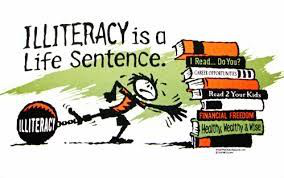
Population
人口
Population is clearly a factor contributing to, and sustaining, high levels of poverty. But the Chinese population control through one-child model would be a bad example to follow for the democratic India
人口显然是造成和持续高度贫穷的一个因素。中国通过独生子女模式控制人口,但对于敏煮的印度来说,这会是一个糟糕的榜样
Gender Inequality
性别不平等
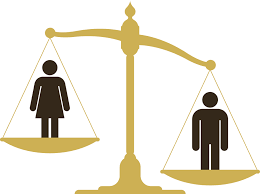
Unequal Distribution of Wealth
财富分配不均
Rich Mumbai.
富裕的孟买
Poor Mumbai.
贫穷的孟买
India happens to be a rich country inhabited by very poor people. – Dr Manmohan Singh.
印度是一个有非常贫穷的人居住的富裕国家。-曼莫汉·辛格。
Corruption:-
Corruption and leakages in government schemes are widespread in India. Late Prime Minister Rajeev Gandhi had famously admitted that only about 15% money actually reaches the ultimate beneficiaries.
腐败
政府规划中的腐败和漏洞在印度非常普遍。已故印度总理拉吉夫•甘地曾有一句名言:实际上,只有大约15%的资金真正惠及最终受益人。
The Colonial Rule
"A significant fact which stands out is that those parts of India which have been longest under British rule are the poorest today." – Jawaharlal Nehru, First Prime Minister of India.
殖民统治
“一个非常值得注意的重要事实是,在英国统治下时间最长的印度地区如今是最贫穷的。”-贾瓦哈拉尔·尼赫鲁,印度第一任总理。
外文链接:https://www.quora.com/Why-is-India-the-largest-poverty-country-in-world
版权声明
我们致力于传递世界各地老百姓最真实、最直接、最详尽的对中国的看法
【版权与免责声明】如发现内容存在版权问题,烦请提供相关信息发邮件,
我们将及时沟通与处理。本站内容除非来源注明五毛网,否则均为网友转载,涉及言论、版权与本站无关。
本文仅代表作者观点,不代表本站立场。
本文来自网络,如有侵权及时联系本网站。
阅读:
-
1
चाइना में रेडी और ठेले Local shops in china || L...
- 2
- 3
- 4
- 5
- 6
- 7
- 8
- 9
- 10
-
1
चाइना में रेडी और ठेले Local shops in china || L...
- 2
- 3
- 4
- 5
- 6
- 7
- 8
- 9
- 10
